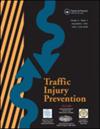Pedestrians’ intent to cross in a fully autonomous vehicle environment; looking at crossing opportunity, eHMI message and wait time
IF 1.6
3区 工程技术
Q3 PUBLIC, ENVIRONMENTAL & OCCUPATIONAL HEALTH
引用次数: 0
Abstract
Objectives
Currently, pedestrians’ road-crossing decisions depend on the traffic at the crossing point, crossing opportunities, and circumstantial elements. Longer wait times on the curb and time pressure raise the number of traffic violations among pedestrians. The era of fully autonomous vehicles (FAVs) promises new interactions. External Human-Machine Interfaces (eHMIs) aim to increase the understanding of FAVs’ intentions and will influence pedestrians’ intent to cross. Yet, how pedestrian behaviors will change in the FAV era remains unclear. Further, there are no good metrics for evaluating the intricate interaction of crossing-related factors.
Methods
In a laboratory study, sixty participants observed crossing scenarios of a typical one-lane road with 10–12 FAVs driving along, two possible eHMI messages (“Cross!”/“Stop!”), and varying crossing opportunities (safe, risky, and unsafe). Participants had to indicate when they intended to cross the road using a designated button. Half of the participants were induced to feel time pressure. We developed index scores to convey the complexity of such crossing situations from the perspective of a pedestrian and used them to analyze the experimental data.
Results
In total, 48% of participants’ indications were to cross in safe crossing opportunities, 34% risky, and 18% unsafe; 69% were made when the eHMI proposition was “Cross!” and 31% for “Stop!”. High, significant, and negative correlations were found for compatible responses, e.g., with a safe crossing gap and an eHMI sign to “Cross!”. The opposite was true for incompatibility, e.g., a safe crossing gap and an eHMI sign to “Stop!” or an unsafe crossing gap and an eHMI sign to “Cross!”. The time pressure group’s median times to cross were shorter, making riskier decisions.
Conclusion
Our findings reflect a tendency to comply with the eHMI. In more complex scenarios where the crossing opportunity was uncertain or waiting times were longer, we observed that pedestrians were more inclined to follow the eHMI’s guidance to cross. These findings suggest that pedestrians may be more likely to follow the eHMI’s suggestion to cross than their self-skill, especially under time pressure. Our indices and metrics reflect the intricate interaction aspects of pedestrian behavior with eHMIs.
行人在完全自动驾驶车辆环境中的过街意图;关注过街机会、eHMI 信息和等待时间。
目标目前,行人过马路的决定取决于过马路点的交通情况、过马路的机会和环境因素。行人在路边等待的时间较长,时间压力较大,从而增加了行人违反交通规则的次数。完全自动驾驶汽车(FAVs)时代将带来新的互动。外部人机交互界面(eHMI)旨在提高人们对自动驾驶汽车意图的理解,并将影响行人的过街意图。然而,在 FAV 时代,行人的行为将发生怎样的变化仍不清楚。此外,目前还没有很好的方法来评估与过马路相关的各种因素之间错综复杂的相互作用:在一项实验室研究中,60 名参与者观察了一条典型的单行道道路的过街情景,该道路上有 10-12 辆 FAV 在行驶,可能有两种 eHMI 消息("过街!"/"停车!"),以及不同的过街机会(安全、有风险和不安全)。参与者必须使用指定按钮指示何时打算横穿马路。一半的参与者被诱导感受时间压力。我们从行人的角度制定了指数评分来表达这种过马路情况的复杂性,并用它们来分析实验数据:总共有 48% 的参与者表示要在安全的过马路机会中过马路,34% 表示有风险,18% 表示不安全;69% 的参与者表示要在 eHMI 提示 "过马路!"时过马路,31% 表示要在提示 "停!"时过马路。在相容的情况下,例如在安全过马路间隙和电子人机界面提示 "过马路!"的情况下,会出现较高的、明显的负相关。而不相容的情况则恰恰相反,例如安全通过间隙和电子人机界面标志 "Stop!"或不安全通过间隙和电子人机界面标志 "Cross!"。时间压力组的过街时间中位数更短,因此做出的决定风险更大:我们的研究结果表明,人们倾向于遵守 eHMI。在过街机会不确定或等待时间较长的复杂场景中,我们观察到行人更倾向于听从 eHMI 的指引过街。这些发现表明,行人可能更倾向于听从 eHMI 的建议过马路,而不是根据自己的技能过马路,尤其是在时间紧迫的情况下。我们的指数和指标反映了行人与电子人机界面之间错综复杂的互动行为。
本文章由计算机程序翻译,如有差异,请以英文原文为准。
求助全文
约1分钟内获得全文
求助全文
来源期刊

Traffic Injury Prevention
PUBLIC, ENVIRONMENTAL & OCCUPATIONAL HEALTH-
CiteScore
3.60
自引率
10.00%
发文量
137
审稿时长
3 months
期刊介绍:
The purpose of Traffic Injury Prevention is to bridge the disciplines of medicine, engineering, public health and traffic safety in order to foster the science of traffic injury prevention. The archival journal focuses on research, interventions and evaluations within the areas of traffic safety, crash causation, injury prevention and treatment.
General topics within the journal''s scope are driver behavior, road infrastructure, emerging crash avoidance technologies, crash and injury epidemiology, alcohol and drugs, impact injury biomechanics, vehicle crashworthiness, occupant restraints, pedestrian safety, evaluation of interventions, economic consequences and emergency and clinical care with specific application to traffic injury prevention. The journal includes full length papers, review articles, case studies, brief technical notes and commentaries.
 求助内容:
求助内容: 应助结果提醒方式:
应助结果提醒方式:


